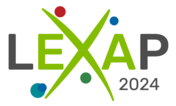Speaker
Description
The possible existence of $\eta^\prime$ meson nucleus bound states ( $\eta^\prime$-mesic nuclei) has been attracting interests both theoretically and experimentally, since in-medium properties of the $\eta^\prime$ meson are closely related to the axial $U(1)$ anomaly and the chiral symmetry in QCD. The especially large mass of the $\eta^\prime$ meson ($\sim$958 MeV/c$^2$) compared with the other light pseudoscalar mesons is theoretically explained by an interplay between the axial $U(1)$ anomaly and spontaneous breaking of chiral symmetry in the QCD vacuum. In the nuclear medium, where chiral symmetry is partially restored, the $\eta^\prime$ meson mass is expected to be reduced. Such a mass reduction would lead to an attractive $\eta^\prime$-nucleus potential, suggesting the existence of bound $\eta^\prime$-mesic nuclei. In two experiments to search for $\eta^\prime$-mesic nuclei, previously performed by using the ($p$,$d$) reaction and the ($\gamma$, $p$) reaction, no significant signal of the $\eta^\prime$-mesic nuclei was observed due to the limited experimental sensitivities.
We have recently performed a new spectroscopic experiment of the $^{12}$C($p$,$dp$) reaction in order to search for $\eta^\prime$-mesic nuclei with an increased experimental sensitivity. We have integrated the WASA central detector into the fragment separator (FRS) at GSI. A 2.5 GeV proton beam impinged on a carbon target to produce $\eta^\prime$-mesic states via the $^{12}$C($p$,$d$)$^{11}$C$\otimes \eta^\prime$ reaction. The missing mass of the reaction is obtained by measuring the deuteron momenta with FRS used as a forward high-resolution spectrometer. Simultaneously, possible decay particles from the $\eta^\prime$-mesic nuclei, especially high-momentum protons ($\sim$1 GeV/$c$) emitted in the decay via the two-nucleon absorption process, are identified with the WASA detector system surrounding the reaction target in order to improve the signal-to-background ratio of the missing-mass spectrum. First data taking was successfully accomplished in February 2022. In this contribution, preliminary results of this experiment and future prospects will be discussed.

